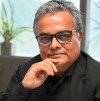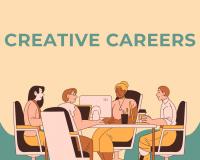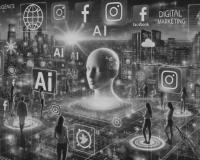The Digital-AI Tsunami in Creative Careers & Learning: Larger Possibilities Ahead!

By Prof Ujjwal K Chowdhury
In my recent article on creative careers and their learning, I have argued that the time for creative careers as a mainstream career choice for the Indian youths has now come decidedly. Questions were raised as to how these careers and their options will shape up in times of the ongoing digital-AI tsunami in this domain. I argue further that the possibilities have actually multiplied for the quality content creators, technicians and the creative economy business professionals, albeit the challenges.
The Creative Economy
We must once again define this sector for clarity of understanding.
The creative economy encompasses a broad spectrum of industries rooted in individual creativity, skill, and talent, with the potential for wealth and job creation through the generation and exploitation of intellectual property. These industries are diverse, ranging from traditional forms of artistic expression to cutting-edge digital endeavours. In India, this landscape includes sectors such as advertising, architecture, arts and crafts, design, fashion, film, video, photography, music, performing arts, publishing, research & development, software, computer games, electronic publishing, and TV/radio. Key sectors within the Indian creative economy showcase the nation's rich cultural heritage and its growing prowess in modern creative fields. Film and entertainment, anchored by Bollywood—the world's largest film industry by volume—along with vibrant regional cinema and the expanding influence of over-the-top (OTT) platforms, represent a significant segment. Fashion and textiles are renowned for their fusion of traditional craftsmanship and contemporary design, with Indian designers gaining international recognition and the textile industry serving as a major exporter. Visual arts and crafts thrive with a vibrant art scene, including globally recognized contemporary artists and a wealth of traditional art forms integral to rural economies. The gaming and digital media sector is experiencing rapid growth, driven by mobile gaming and the rise of content creators on platforms like YouTube and Instagram. India also boasts a robust publishing industry producing literature in numerous languages, with Indian authors achieving worldwide acclaim. The creative economy contributes significantly to India's economic output, accounting for an estimated INR 50,000 crore (US $6.14 billion) in 2019-20 and now standing as a USD 30 billion industry. Furthermore, India holds considerable export potential in both creative goods and services. The Indian creative economy's multifaceted nature, encompassing both established and emerging sectors, indicates the varied ways in which digital and AI-ML technologies are poised to make a substantial impact.
The Digital-AI Tsunami Herein:
From Instagram Reels to YouTube Shorts, Canva to CapCut, Indian creators from the heart of Malda to the bustle of Mumbai are making content with zero legacy, often with just a smartphone. Algorithms can now push your poem, sketch, or music video to a million in a day—if it's compelling enough. A case in point is Shivani Bafna, a dancer and content creator, built a full-fledged personal brand out of Bollywood dance, mental health storytelling, and US-India lifestyle vlogging, thanks to the reach of social platforms and intelligent recommendation engines.
AI is not just about ChatGPT writing poems or Midjourney designing logos. It’s about creative acceleration. For the writers, GrammarlyGO, Jasper, and ChatGPT help ideate faster, create drafts, adapt tone and even localize. For the designers, Adobe Firefly, DALL·E, and Runway ML generate mock-ups, mood-boards, and campaign visuals in seconds. For the filmmakers, Descript and Pictory.ai allow rapid, AI-driven editing and subtitling. For the musicians, tools like AIVA and Amper create AI-assisted compositions for commercials and background scores. Tars, an Indian no-code platform using conversational AI, helps brands build storytelling chatbots that act as customer journey companions—designed by creative technologists.
Event creative learning is becoming smarter, faster and wider. AI-powered platforms are revolutionizing learning pathways. Skill development apps like FrontRow, Stage, and SkillShare (some India-based) bring experts directly to aspirants in Tier 2-3 cities. Immersive AR-VR labs in creative schools are helping students “experience design” before doing it. Bhavan’s MSEED Mumbai, for instance, is integrating XR tools into storytelling and event design curricula, enabling students to simulate stage shows, fashion events, or ad campaigns virtually.
AI and ML technologies are automating repetitive tasks in design, such as the resizing of images, correction of colours, and optimization of layouts. This allows graphic designers and other visual artists to focus on more complex and imaginative aspects of their work. Content creation processes are also being streamlined, with AI algorithms assisting in tasks like video editing, proofreading, and even the generation of advertising copy. In media production, AI is accelerating workflows in post-production by enhancing contrast, adjusting colouring, and improving the resolution of imagery. For example, AI-powered tools like Luminar are used for sophisticated photo editing, and composers are leveraging AI music composition tools to generate original soundtracks more easily. This increase in efficiency allows creative professionals in India to produce a higher volume of work with greater speed, ultimately enhancing their productivity.
AI-ML algorithms are enabling highly personalized experiences for consumers of creative content in India. Content recommendation systems on media platforms like Spotify and Apple Music suggest songs based on individual listening patterns, while OTT platforms like Amazon and Netflix recommend movies and shows based on viewing history. In marketing and advertising, AI analyses consumer behaviour and preferences to deliver more targeted and personalized campaigns. Within design, AI can analyse customer demographics and past interactions to provide tailored recommendations, allowing designers to create content that resonates more effectively with specific audience segments. This ability to deliver hyper-personalized experiences across various touchpoints enhances customer satisfaction and engagement.
AI-ML technologies offer powerful tools for analysing audience behaviour and preferences in India. By scrutinizing vast amounts of data from social media and other digital platforms, AI algorithms can identify trends and provide insights into what resonates with specific demographics. This allows for enhanced targeting of advertisements and marketing campaigns, ensuring that content reaches the right audience at the right time. Data-driven insights derived from AI analysis also inform content creation and distribution strategies, enabling businesses to refine their approaches for maximum impact. For instance, AI can identify highly specialized groups of users, allowing for more focused and effective marketing efforts.
The adoption of AI-ML in India's creative industries can lead to significant cost reductions by automating tasks that previously required large teams or specialized personnel. Furthermore, the increasing availability of affordable digital tools and AI-powered platforms is lowering the entry barriers for individual creators, making it more feasible to pursue creative careers. Government-backed initiatives, such as the proposed National Creative Cloud Platform, aim to further democratize access to expensive creative software and cloud computing resources, enabling smaller studios and startups to compete more effectively. This increased accessibility fosters a more inclusive and vibrant creative ecosystem across the country.
AI-ML technologies offer significant advantages in bridging language barriers within India's diverse linguistic landscape. AI tools can facilitate multilingual content creation and translation, enabling creative professionals to reach wider audiences across different regions. Automated journalism systems are now capable of producing news stories in multiple languages, catering to the diverse linguistic needs of the Indian population.
Challenges & Cautions in the Age of AI:
But then the challenges are galore in this emerging phenomenon. The first is the debate on authenticity versus algorithm. AI can help you create—but can also flood the market with mediocre, templated content. The challenge? Standing out with soul. When AI generates hundreds of visuals or scripts, human intuition, emotional layering, and originality will define quality. The cautionary tale here is that several digital creators have been flagged for “deepfake influencers” or overuse of AI-generated art without human essence. Audiences are quick to call out what feels fake.
Then there is the issue of job displacement and role mutation. Traditional roles—like photo editors, script assistants, illustrators—are being disrupted. Instead, new roles are emerging, like the prompt engineer, AI-curated content specialist, and creative technologist. Creative careers are shifting from "doing" to "directing the doing." According to a 2024 NASSCOM report, over 40% of creative media professionals in India will need upskilling in AI and data tools by 2027. That is the only way to be relevant in the market, apart from keeping authenticity and originality of content alive.
Then there are the ethical & legal grey zones. Who owns AI-generated art? Ghibli style art flooding the social media is a fit case in this debate. Algorithmic bias, where AI models inherit biases from their training data, can lead to unfair or discriminatory outcomes in content creation and design. Issues related to copyright and intellectual property become more complex when dealing with AI-generated designs and content, often leading to disputes and legal uncertainties. Furthermore, the potential for AI to be used in creating and spreading misinformation and deepfakes poses a serious challenge to the integrity of media and communication. Careful regulation and ethical guidelines are essential to address these emerging risks. What if AI copies a copyrighted melody which it is doing left, right and centre? India’s legal framework is still evolving. Creative professionals need tech-literacy and legal awareness as core career skills now.
While AI-ML tools can augment creativity, they currently lack the nuanced understanding of human emotion, empathy, and the ability to inject genuine human touch into creative work. There is a concern that over-reliance on AI could lead to a homogenization of design aesthetics, resulting in a lack of originality and distinctiveness in creative outputs. For instance, some argue that AI-generated art, while technically proficient, may lack the soul and emotional depth that characterizes human artistic expression.
India’s Response: Promising Moves on Ground
Education gets future-ready. NID Ahmedabad is collaborating with tech partners to explore AI in textile and visual design. Whistling Woods International has launched courses on Virtual Production & AI in Filmmaking. MSEED, the new-age creative management institute in the Bhavan’s campus of Mumbai, emphasizes AI tools in communication, design, and entertainment education.
Then there are startups powering creative-AI. Gan.ai, a video personalization platform, allows creators to make multiple versions of a video with just one shoot. Beatoven.ai lets creators generate royalty-free background scores using AI for podcasts, films, and reels. Animeta, a creator economy tech platform, supports Indian influencers with AI-driven performance analytics.
There is AI-enhanced artistry like that of the Mumbai Art Collective which uses MidJourney and Stable Diffusion to reimagine Raja Ravi Varma’s paintings in AR, attracting younger audiences. There is the Carnatic Music synthesis, in which Chennai’s A.R. Rahman Foundation trains AI models on M.S. Subbulakshmi’s recordings to generate new raga-based compositions. There also is the collaborative creativity. AI Scriptwriting Assistants are rising. Platforms like Scrite analyse box-office data to suggest plot tweaks for regional cinema, as seen in the Telugu blockbuster Pushpa 2. There are Virtual Productions as well. YRF Studios uses Unreal Engine’s AI to create real-time backgrounds, cutting VFX costs by 40% for films like Pathaan.
We also have a rising trend of inclusive Design for the dfferently-abled creators. Bengaluru’ Inclusive Minds Lab employs AI voice-to-text tools to help dyslexic writers publish novels, such as the bestselling Whispers of the Silent Mind.
There is a distinct state & industry push visible. The AVGC (Animation, Visual Effects, Gaming, Comics) Task Force set up by the Government of India is exploring AI-led innovation zones. FICCI Frames 2025 spotlighted AI-Driven Storytelling as its central theme, with focus on ethical creative innovation.
Notable Indian initiatives also include the Digital India Bhashini that supports AI-driven translation for 22 languages, enabling Tamil poets to collaborate with Punjabi illustrators on cross-cultural comics. IIT Bombay-Ministry of Culture Partnership is digitizing 10,000+ folk art pieces using AI, creating a marketplace for artisans. FICCI Frames Accelerator is funding AI startups like DeepReel, which automates video editing for small YouTubers.
The Road Ahead: A Human-Tech Collaboration: 5th Generation Technology:
Creative careers are no longer only about performance, design, or storytelling—they’re about transmedia fluency: How you move across formats, scale through tech, and create immersive impact. Herein lies the future possibilities of the master story-tellers, creative economy technicians and business professionals.
The new creative genius is part artist, part technologist, part entrepreneur. To thrive, they are learning AI tools, but leading with human insight. They are understanding platforms, but focussing on purpose. They are adapting to change, but never abandoning their voice.
Digital platforms are democratizing access to creative education in India, breaking down geographical and socioeconomic barriers. Online courses and learning platforms such as Udemy, Coursera, Skillshare, and Alison offer a vast array of digital art courses, making learning more affordable and convenient. Indian platforms like Hunar Online Course provide government-certified courses in fashion, food, and beauty, often available in regional languages, reaching a wider audience. Institutions like Himanshu Art Institute and Kamal Art Institute offer online classes in fine arts, painting, drawing, and crafts, catering to various age groups and skill levels. Platforms like Rooftop and The Hobby Tribe focus on Indian art forms and various hobbies, respectively, offering workshops and courses online. The Asian Institute of Design (AID) provides degree and diploma courses in digital art, animation, and game programming. This widespread availability of online learning resources is significantly increasing the accessibility of creative education across India. The National Educational Technology Forum (NETF), proposed under the National Education Policy (NEP) 2020, aims to further enhance this by facilitating the free exchange of ideas on digitization and online education in higher education.
India is not just consuming creative content anymore—it is shaping global culture, and AI is its amplifier. This is the new Rasa Yatra—a journey of emotion, technology, expression, and enterprise. Digital and AI-ML are not threats to creative careers. They are the wings. The question is—are you learning to fly?
The author is currently the Director General of Management School of Events, Entrepreneurship and Design (MSEED) in the Bharatiya Vidya Bhavan’s campus in Andheri West, Mumbai. He was earlier the Pro Vice Chancellor of Kolkata based Adamas University and Dean of Media and Design in Symbiosis and Amity Universities, Pearl Academy and Whistling Woods International.
000
About The Author

Prof Ujjwal K Chowdhury is currently the Director General of Management School of Events, Entertainment and Design (MSEED) in the Bhavan's College campus of Andheri, and is also the Vice President of Global Media Education Council. He was till December, 2024, the Vice President, Global Marketing, International Relations, and Media-Design Education of Washington University of Science and Technology, based out of Virginia. He had been earlier the Pro Vice Chancellor of Kolkata based Adamas University, Dean of Symbiosis and Amity Universities, Pearl Academy and Whistling Woods International, all of India. He had been Dean of the Amsterdam Film School and Strategic Adviser of Daffodil International University of Bangladesh. He had worked in the World Health Organization, Times of India Group, Zee News and Business World. He runs a school for the talented children of marginalized fishermen families in the Sundarban area of Bengal and Bangladesh border.



.jpeg)





